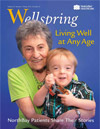Off the Disabled List, Back on the Court
 Surgeon Andrew Brooks, M.D., is pleased that through hard work and exercise, his patient Ennis Sandle was able to regain his strength and flexibility after surgery to repair a torn anterior cruciate ligament.
Surgeon Andrew Brooks, M.D., is pleased that through hard work and exercise, his patient Ennis Sandle was able to regain his strength and flexibility after surgery to repair a torn anterior cruciate ligament.
It was the third quarter on a Tuesday night—Dec. 22, 2009—and Dixon High shooting guard Ennis Sandle remembers making a bad pass,
swatting it out of a Vacaville High player’s hands, and then falling.
Dixon High’s junior varsity Rams were victorious, but Ennis lost that season and the next. He had hyper-extended his knee and had to be carried back to the bench.
Hard work is the key to a successful recovery, even though progress can be slow at times.
—Bob Blakewell, Physical Therapist
His mother, Jennifer Sandle, sitting in the stands, didn’t realize how bad the injury was at first. “After the game, she tried to get me to walk on it, to do lunges,” Ennis remembers with a grimace. “I said, ‘Mom, I can’t even walk on it!’”
Days later, an x-ray confirmed he hadn’t broken anything, but his knee was swollen to the size of
a small melon. Jennifer, an ER support specialist for NorthBay Healthcare, wasn’t content to send him off to therapy; she wanted to know just what was wrong, so she asked his doctor, Matthew Heeren, M.D., at NorthBay Healthcare’s Center for Primary Care in Vacaville.
He promptly ordered an MRI, which confirmed the Sandles’ worst fears: a torn anterior cruciate ligament, or ACL, as it is commonly called. Athletes are the most susceptible, as the ACL helps players
as they pivot and lunge.
Because Ennis was still growing, his surgeon,
Dr. Andrew Brooks, advised against having surgery right away. “There’s concern about damaging growth plates,” explains Dr. Brooks. “We don’t always have the luxury of waiting until someone is mature enough for the surgery, but in Ennis’ case, we did.” Despite the injury, Ennis managed to attend every game his sophomore year and support his team from the bench.
He was finally cleared for surgery in September 2010, and spent the next year regaining his strength and skills. He only missed two days of school, although he was in pain and on crutches for months. He had to wear a leg brace much of that time, which limited mobility for his 5-foot-11 frame.
“Ennis is a unique guy,” remembers Dr. Brooks. “He had a great support system at home, which makes a big difference. And he’s extremely intelligent, highly motivated and understood the importance of hard work. He did what I asked him to do, and probably more.”
In the gym at Dixon Fitness, Ennis stuck to upper body workouts with his trainer Chris McCoy, and in therapy, he pushed to gain strength and flexibility in his knee.
Bob Blakewell, a NorthBay physical therapist, worked with Ennis two to three times a week after his surgery and was impressed with his tenacious, focused approach. “He was really an inspiration to all our other patients,” says Bob. “He worked so hard, never complained and was focused on playing basketball again. His good work ethic rubbed
off on a couple of other young surgical patients we had at the time.” Hard work, says Bob, is the key to a successful recovery. “Ennis understood that, even though progress was slow at times.”
His goal this past fall was simple: To make Dixon High’s varsity basketball team. Of course with a new coach in town, Ennis wasn’t sure what to expect. He felt strong, and he was ready to work hard, but he didn’t know if Coach Samuel Harrison would have any hesitation putting him on the team.
In November, he got the good news: He would play varsity. “Ennis was ready to do whatever it took to be a complete player and help the team win,” says Coach Harrison. “The conditioning he did prior to tryouts really helped. He’s a great kid, with a great GPA.” In fact, despite his hardships, Ennis, now 17, has maintained a 4.0 GPA.
Dr. Heeren, who has been Ennis’ doctor for years, says the news didn’t surprise him. “I’ve always admired his work ethic and determination,” he says. “I have no doubt he’ll succeed with any path he pursues.”
So what will be his field of study when it’s time for college? “Definitely medicine,” says Ennis. “Maybe pharmacy, or maybe even orthopaedics.” After all, he points out, with his experience he could well prepare a patient for knee surgery.
 Just the Facts – ACL Injuries
Just the Facts – ACL Injuries
An injury to the ACL, or anterior cruciate ligament, is one of the most common knee injuries, says orthopaedic surgeon Andrew Brooks, M.D., who notes that 90 percent of these type of injuries occur during sporting events.
Dr. Brooks recommends athletes stretch prior to working out and focus on strengthening muscles in their legs to help avoid potential tears.
He notes that while such injuries are common in male-dominated football and basketball, female athletes are actually more at risk for an ACL tear.
The ACL can be injured in several ways:
- Changing direction rapidly.
- Stopping suddenly.
- Slowing down while running.
- Landing from a jump incorrectly.
- Direct contact or collision, such as a football tackle.
The surgery to repair an ACL tear is complicated, can take more than two hours to perform and involves more than 100 steps. “And every step is vital,” says Dr. Brooks.

